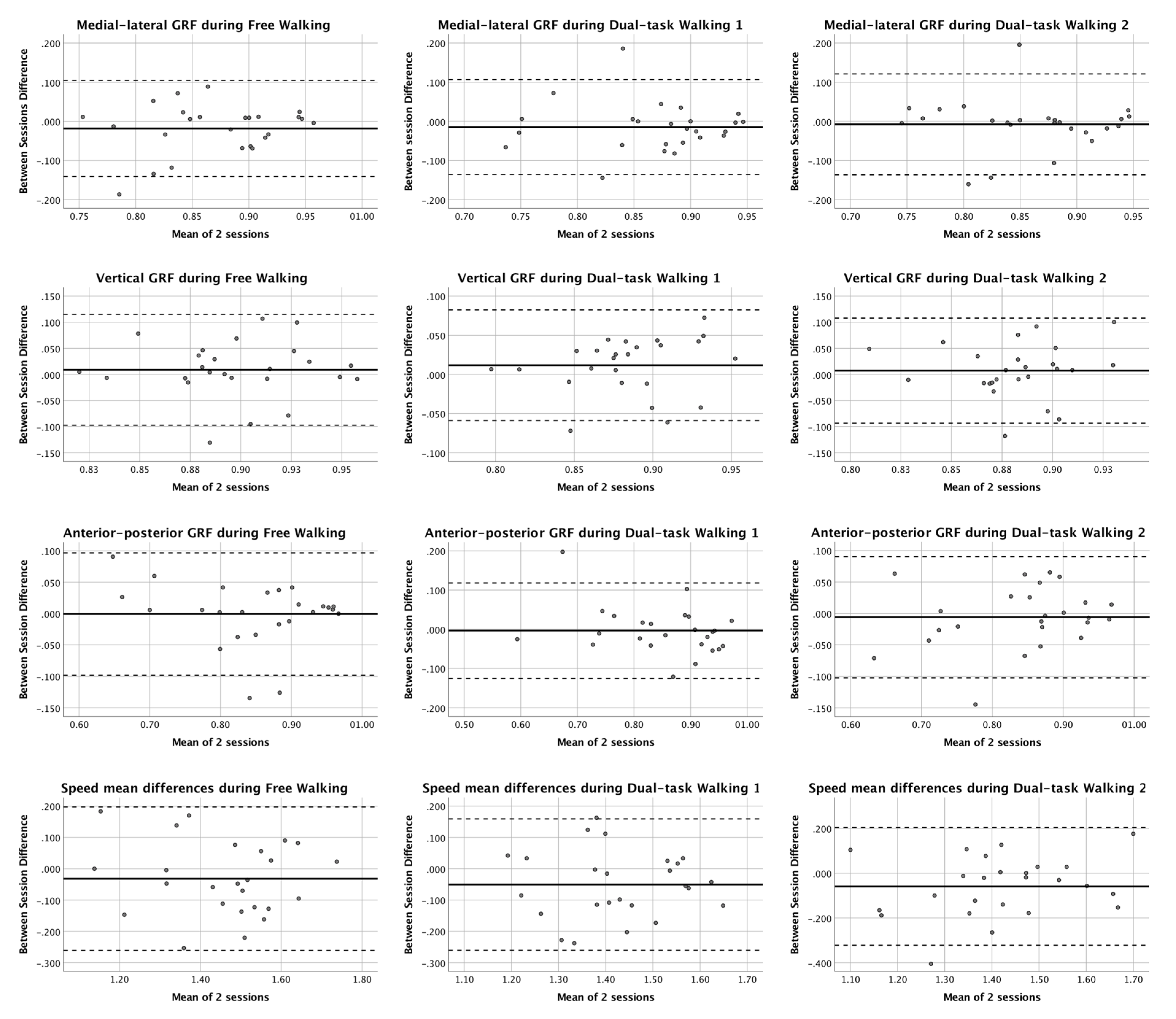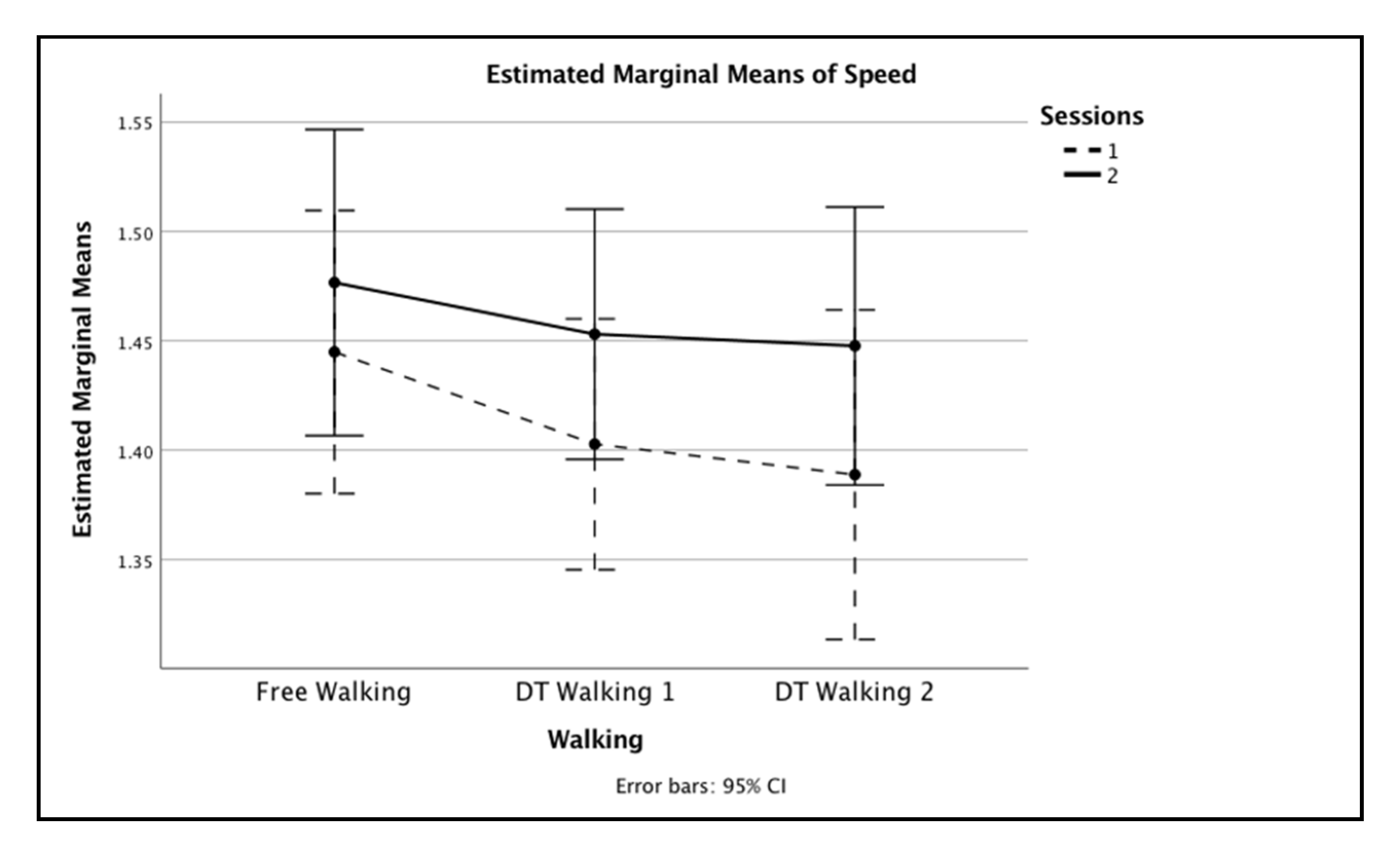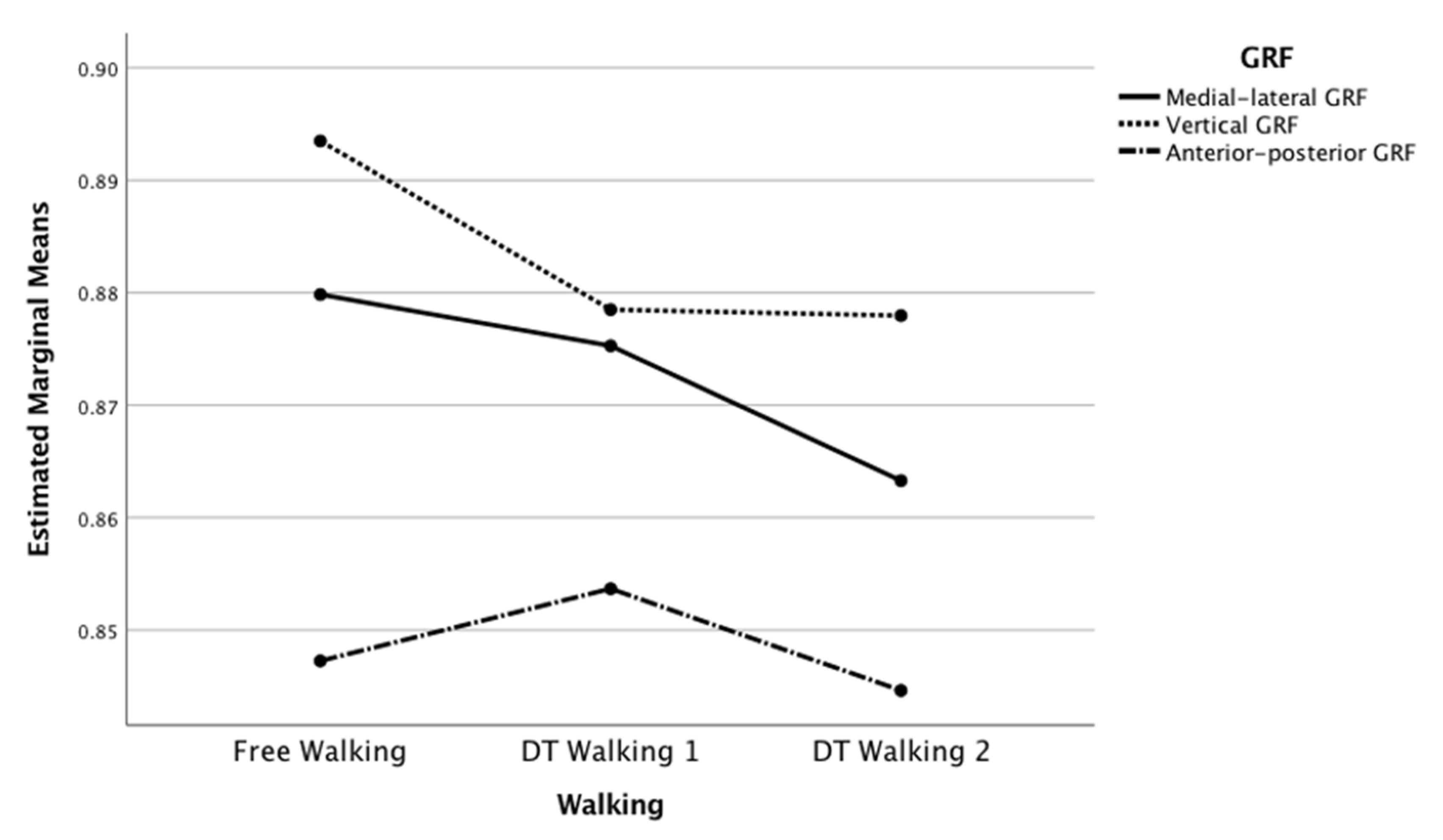An Evaluation of Symmetries in Ground Reaction Forces during Self-Paced Single- and Dual-Task Treadmill Walking in the Able-Bodied Men
Abstract
:1. Introduction
2. Materials and Methods
2.1. Participants
2.2. Experimental Procedure
2.3. Data Processing
2.4. Statistical Analysis
3. Results
4. Discussion
5. Conclusions
Author Contributions
Funding
Acknowledgments
Conflicts of Interest
References
- Nasirzade, A.; Sadeghi, H.; Mokhtarinia, H.R.; Rahimi, A. A review of selected factors affecting gait symmetry. Phys. Treat. Specif. Phys. Ther. 2017, 7, 3–12. [Google Scholar] [CrossRef] [Green Version]
- Hsiao-Wecksler, E.T.; Polk, J.D.; Rosengren, K.S.; Sosnoff, J.J.; Hong, S. A review of new analytic techniques for quantifying symmetry in locomotion. Symmetry 2010, 2, 1135–1155. [Google Scholar] [CrossRef] [Green Version]
- Ankarali, M.M.; Sefati, S.; Madhav, M.; Long, A.; Bastian, A.; Cowan, N. Walking dynamics are symmetric (enough). J. R. Soc. Interface 2015, 12, 20150209. [Google Scholar] [CrossRef] [PubMed] [Green Version]
- Wu, J.; Wu, B. The novel quantitative technique for assessment of gait symmetry using advanced statistical learning algorithm. Biomed Res. Int. 2015, 2015, 528971. [Google Scholar] [CrossRef] [PubMed]
- Toro, B.; Nester, C.; Farren, P. A review of observational gait assessment in clinical practice. Physiother. Theory Pract. 2009, 19, 137–149. [Google Scholar] [CrossRef]
- Baker, R.; Esquenazi, A.; Benedetti, M.G.; Desloovere, K. Gait analysis: Clinical facts. Eur. J. Phys. Rehabil. Med. 2016, 52, 560–574. [Google Scholar]
- Herzog, W.; Nigg, B.M.; Read, L.J.; Olsson, E. Asymmetries in ground reaction force patterns in normal human gait. Med. Sci. Sports Exerc. 1988, 21, 1689–1699. [Google Scholar] [CrossRef]
- Seeley, M.K.; Umberger, B.R.; Shapiro, R. A test of the functional asymmetry hypothesis in walking. Gait Posture 2008, 28, 24–28. [Google Scholar] [CrossRef]
- Giakas, G.; Baltzopoulos, V. Time and frequency domain analysis of ground reaction forces during walking: An investigation of variability and symmetry. Gait Posture 1997, 5, 189–197. [Google Scholar] [CrossRef]
- Forczek, W.; Staszkiewicz, R. An evaluation of symmetry in the lower limb joints during the able-bodied gait of women and men. J. Hum. Kinet. 2012, 35, 47–57. [Google Scholar] [CrossRef] [Green Version]
- Sadeghi, H. Local or global asymmetry in gait of people without impairments. Gait Posture 2003, 17, 197–204. [Google Scholar] [CrossRef]
- Burnett, D.R.; Campbell-Kyureghyan, N.H.; Cerrito, P.B.; Quesada, P.M. Symmetry of ground reaction forces and muscle activity in asymptomatic subjects during walking, sit-to-stand, and stand-to-sit tasks. J. Electromyogr. Kinesiol. 2011, 21, 610–615. [Google Scholar] [CrossRef] [PubMed]
- Viteckova, S.; Kutilek, P.; Svoboda, Z.; Krupika, R.; Kauler, J.; Szabo, Z. Gait symmetry measures: A review of current and prospective methods. Biomed. Signal Process. Control 2018, 42, 89–100. [Google Scholar] [CrossRef]
- Jeleń, P.; Wit, A.; Dudziński, K.; Nolan, L. Expressing gait-line symmetry in able-bodied gait. Dyn. Med. 2008, 7, 1–9. [Google Scholar] [CrossRef] [PubMed] [Green Version]
- Vaverka, F.; Elfmark, M.; Svoboda, Z.; Janura, M. System of gait analysis based on ground reaction force assessment. Acta Gymnica 2015, 45, 187–193. [Google Scholar] [CrossRef] [Green Version]
- Wang, Y.; Watanabe, K. Symmetry and variability of vertical ground reaction force and center of pressure in able-bodied gait. J. Appl. Biomech. 2012, 28, 473–478. [Google Scholar] [CrossRef]
- Plotnik, M.; Bartsch, R.P.; Zeev, A.; Giladi, N.; Hausdorff, J.M. Effects of walking speed on asymmetry and bilateral coordination of gait. Gait Posture 2013, 38, 864–869. [Google Scholar] [CrossRef] [Green Version]
- Al-Amri, M.; Al Balushi, H.; Mashabi, A. Intra-rater repeatability of gait parameters in healthy adults during self-paced treadmill-based virtual reality walking. Comput. Methods Biomech. Biomed. Engin. 2017, 20, 1669–1677. [Google Scholar] [CrossRef] [Green Version]
- Luigi Tesio, V.R. Gait analysis on split-belt force treadmills: Validation of an instrument. Am. J. Phys. Med. Rehabil. 2008, 87, 515–526. [Google Scholar] [CrossRef]
- Yogev-Seligmann, G.; Hausdorff, J.M.; Giladi, N. The role of executive function and attention in gait. Mov. Disord. 2008, 23, 329–342. [Google Scholar] [CrossRef] [Green Version]
- Mendel, T.; Barbosa, W.O.; Sasaki, A.C. Dual task training as a therapeutic strategy in neurologic physical therapy: A literature review. Acta Fisiátrica 2015, 22, 206. [Google Scholar] [CrossRef] [Green Version]
- Gillain, S.; Boutaayamou, M.; Schwartz, C.; Dardenne, N.; Bruyère, O.; Brüls, O.; Croisier, J.-L.; Salmon, E.; Reginster, J.-Y.; Garraux, G.; et al. Gait symmetry in the dual task condition as a predictor of future falls among independent older adults: A 2-year longitudinal study. Aging Clin. Exp. Res. 2019, 3, 1057–1067. [Google Scholar] [CrossRef] [PubMed] [Green Version]
- Al-Yahya, E.; Dawes, H.; Smith, L.; Dennis, A.; Howells, K.; Cockburn, J. Cognitive motor interference while walking: A systematic review and meta-analysis. Neurosci. Biobehav. Rev. 2011, 35, 715–728. [Google Scholar] [CrossRef] [PubMed]
- Hollman, J.H.; Kovash, F.M.; Kubik, J.J.; Linbo, R.A. Age-related differences in spatiotemporal markers of gait stability during dual task walking. Gait Posture 2007, 26, 113–119. [Google Scholar] [CrossRef]
- Schaefer, S.; Lindenberger, U. Thinking while walking: Experienced high-heel walkers flexibly adjust their gait. Front. Psychol. 2013, 4, 1–7. [Google Scholar] [CrossRef] [Green Version]
- Yogev, G.; Plotnik, M.; Peretz, C.; Giladi, N.; Hausdorff, J.M. Gait asymmetry in patients with Parkinson’s disease and elderly fallers: When does the bilateral coordination of gait require attention? Exp. Brain Res. 2007, 177, 336–346. [Google Scholar] [CrossRef]
- Plotnik, M.; Giladi, N.; Hausdorff, J.M. Bilateral coordination of gait and Parkinson’s disease: The effects of dual tasking. J. Neurol. Neurosurg. Psychiatry 2009, 80, 347–350. [Google Scholar] [CrossRef]
- Ribeiro, T.S.; de Sousa, A.C.; de Lucena, L.C.; Santiago, L.M.; Lindquist, A.R. Does dual task walking affect gait symmetry in individuals with Parkinson’s disease? Eur. J. Physiother. 2018, 21, 8–14. [Google Scholar] [CrossRef]
- Faul, F.; Erdfelder, E.; Axel, B.; Lang, A.-G. Statistical power analyses using G*Power 3.1: Tests for correlation and regression analyses. Behav. Res. Methods 2009, 41, 1149–1160. [Google Scholar] [CrossRef] [Green Version]
- Kimura, N.; van Deursen, R. The effect of visual dual-tasking interference on walking in healthy young adults. Gait Posture 2020, 79, 80–85. [Google Scholar] [CrossRef]
- Van den Bogert, A.J.; Geijtenbeek, T.; Even-Zohar, O.; Steenbrink, F.; Hardin, E.C. A real-time system for biomechanical analysis of human movement and muscle function. Med. Biol. Eng. Comput. 2013, 51, 1069–1077. [Google Scholar] [CrossRef] [PubMed] [Green Version]
- Sloot, L.H.; van der Krogt, M.M.; Harlaar, J. Effects of adding a virtual reality environment to different modes of treadmill walking. Gait Posture 2014, 39, 939–945. [Google Scholar] [CrossRef] [PubMed]
- Meyer, C.; Kileen, T.; Easthope, C.; Curt, A.; Bollinger, M.; Linnebank, M.; Zörner, B.; Filley, L. Familiarization with treadmill walking: How much is enough? Sci. Rep. 2019, 9, 1–10. [Google Scholar] [CrossRef] [PubMed]
- Seltman, H. Experimental Design and Analysis. 2018. Available online: http://www.stat.cmu.edu/~hseltman/309/Book/Book.pdf (accessed on 28 November 2020).
- Nadkarni, N.K.; Zabjek, K.; Lee, B.; McIlroy, W.E.; Black, S.E. Effect of working memory and spatial attention tasks on gait in healthy young and older adults. Mot. Control 2010, 14, 195–210. [Google Scholar] [CrossRef] [Green Version]
- Monk, A.F.; Jackson, D.; Nielsen, D.; Jefferies, E.; Olivier, P. N-backer: An auditory n-back task with automatic scoring of spoken responses. Behav. Res. Methods 2011, 43, 888–896. [Google Scholar] [CrossRef] [Green Version]
- Lövdén, M.; Schaefer, S.; Pohlmeyer, A.E.; Lindenberger, U. Walking variability and working-memory load in aging: A dual-process account relating cognitive control to motor control performance. J. Gerontol. B Psychol. Sci. Soc. Sci. 2008, 63, 121–128. [Google Scholar] [CrossRef]
- Liao, F.; Wang, J.; He, P. Multi-resolution entropy analysis of gait symmetry in neurological degenerative diseases and amyotrophic lateral sclerosis. Med. Eng. Phys. 2008, 30, 299–310. [Google Scholar] [CrossRef]
- Robinson, R.O.; Herzog, W.; Nigg, B.M. Use of force platform variables to quantify the effects of chiropractic manipulation on gait symmetry. J. Manip. Physiol. Ther. 1987, 10, 172–176. [Google Scholar]
- Liikavainio, T.; Isolehto, J.; Helminen, H.J.; Perttunen, J.; Lepola, V.; Kiviranta, I.; Arokoski, J.P.A.; Komi, P.V. Loading and gait symmetry during level and stair walking in asymptomatic subjects with knee osteoarthritis: Importance of quadriceps femoris in reducing impact force during heel strike? Knee 2007, 14, 231–238. [Google Scholar] [CrossRef]
- Yiou, E.; Caderby, T.; Delafontaine, A.; Fourcade, P.; Honeine, J.L. Balance control during gait initiation: State-of-the-art and research perspectives. World J. Orthop. 2017, 8, 815–828. [Google Scholar] [CrossRef]
- Paul, S.S.; Ada, L.; Canning, C.G. Automaticity of walking—Implications for physiotherapy practice. Phys. Ther. Rev. 2005, 10, 15–23. [Google Scholar] [CrossRef]
- Marasović, T.; Cecić, M.; Zanchi, V. Analysis and interpretation of ground reaction forces in normal gait. WSEAS Trans. Syst. 2009, 8, 1105–1114. [Google Scholar]
- Dos Santos, D.A.; Fukuchi, C.A.; Fukuchi, R.K.; Duarte, M. A data set with kinematic and ground reaction forces of human balance. PeerJ 2017, 5, e3626. [Google Scholar] [CrossRef] [PubMed] [Green Version]
- Yogev-Seligmann, G.; Giladi, N.; Gruendlinger, L.; Hausdorff, J.M. The contribution of postural control and bilateral coordination to the impact of dual tasking on gait. Exp. Brain Res. 2013, 226, 81–93. [Google Scholar] [CrossRef] [PubMed]
- Owen, A.M.; McMillan, K.M.; Laird, A.R.; Bullmore, E. N-Back working memory paradigm: A meta-analysis of normative functional neuroimaging studies. Hum. Brain Mapp. 2005, 25, 46–59. [Google Scholar] [CrossRef] [PubMed] [Green Version]
- Studer, M.; Winningham, R. Retraining automaticity: Recovering the procedural memory of walking after stroke. Phys. Med. Rehabil. Int. 2017, 4, 1125. [Google Scholar] [CrossRef] [Green Version]




| Demographic Measure | Mean ± SD | Range |
|---|---|---|
| Age (years) | 34.00 ± 4.44 | 30–46 |
| Height (m) | 1.71 ± 0.06 | 1.58–1.82 |
| Weight (kg) | 76.88 ± 9.85 | 57.60–100.2 |
| BMI (kg/m2) | 26.17 ± 2.48 | 19.50–30.20 |
| Session 1 | Session 2 | Sessions Combined | t-Test p | 95%CI | ||||
|---|---|---|---|---|---|---|---|---|
| Mean ± SD | CV% | Mean ± SD | CV% | Difference ± SD | ||||
| Medial–lateral | FW | 0.862 ± 0.069 | 8.0 | 0.880 ± 0.059 | 6.7 | −0.018 ± 0.063 | 0.161 | −0.044 to 0.008 |
| DT1 | 0.861 ± 0.068 | 7.9 | 0.875 ± 0.069 | 7.9 | −0.015 ± 0.062 | 0.252 | −0.040 to 0.011 | |
| DT2 | 0.856 ± 0.069 | 8.1 | 0.863 ± 0.070 | 8.1 | −0.008 ± 0.066 | 0.562 | −0.035 to 0.019 | |
| Vertical | FW | 0.902 ± 0.044 | 4.9 | 0.893 ± 0.044 | 4.9 | 0.009 ± 0.054 | 0.421 | −0.014 to 0.031 |
| DT1 | 0.890 ± 0.044 | 4.9 | 0.879 ± 0.038 | 4.3 | 0.012 ± 0.036 | 0.116 | −0.003 to 0.027 | |
| DT2 | 0.885 ± 0.038 | 4.3 | 0.878 ± 0.037 | 4.2 | 0.007 ± 0.051 | 0.490 | −0.014 to 0.028 | |
| Anterior–posterior | FW | 0.847 ± 0.090 | 10.6 | 0.847 ± 0.102 | 12.0 | −0.001 ± 0.050 | 0.950 | −0.021 to 0.020 |
| DT1 | 0.850 ± 0.093 | 10.9 | 0.854 ± 0.112 | 13.1 | −0.003 ± 0.062 | 0.787 | −0.029 to 0.22 | |
| DT2 | 0.839 ± 0.101 | 12.0 | 0.845 ± 0.091 | 10.8 | −0.006 ± 0.049 | 0.553 | −0.026 to 0.014 | |
| Speed (m/s) | FW | 1.45 ± 0.157 | 9.0 | 1.48 ± 0.170 | 8.8 | −0.032 ± 0.117 | 0.187 | −0.080 to 0.017 |
| DT1 | 1.40 ± 0.139 | 9.7 | 1.45 ± 0.139 | 8.8 | −0.050 ± 0.107 | 0.027 * | −0.094 to −0.006 | |
| DT2 | 1.39 ± 0.182 | 9.6 | 1.45 ± 0.154 | 9.0 | −0.059 ± 0.134 | 0.038 * | −0.114 to −0.003 | |
Publisher’s Note: MDPI stays neutral with regard to jurisdictional claims in published maps and institutional affiliations. |
© 2020 by the authors. Licensee MDPI, Basel, Switzerland. This article is an open access article distributed under the terms and conditions of the Creative Commons Attribution (CC BY) license (http://creativecommons.org/licenses/by/4.0/).
Share and Cite
Al-Juaid, R.; Al-Amri, M. An Evaluation of Symmetries in Ground Reaction Forces during Self-Paced Single- and Dual-Task Treadmill Walking in the Able-Bodied Men. Symmetry 2020, 12, 2101. https://doi.org/10.3390/sym12122101
Al-Juaid R, Al-Amri M. An Evaluation of Symmetries in Ground Reaction Forces during Self-Paced Single- and Dual-Task Treadmill Walking in the Able-Bodied Men. Symmetry. 2020; 12(12):2101. https://doi.org/10.3390/sym12122101
Chicago/Turabian StyleAl-Juaid, Rawan, and Mohammad Al-Amri. 2020. "An Evaluation of Symmetries in Ground Reaction Forces during Self-Paced Single- and Dual-Task Treadmill Walking in the Able-Bodied Men" Symmetry 12, no. 12: 2101. https://doi.org/10.3390/sym12122101





